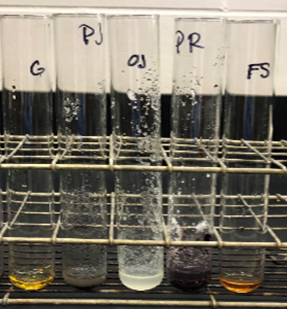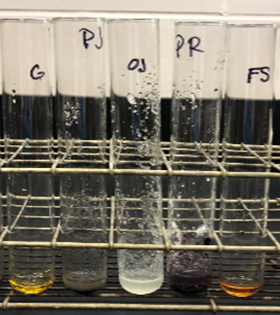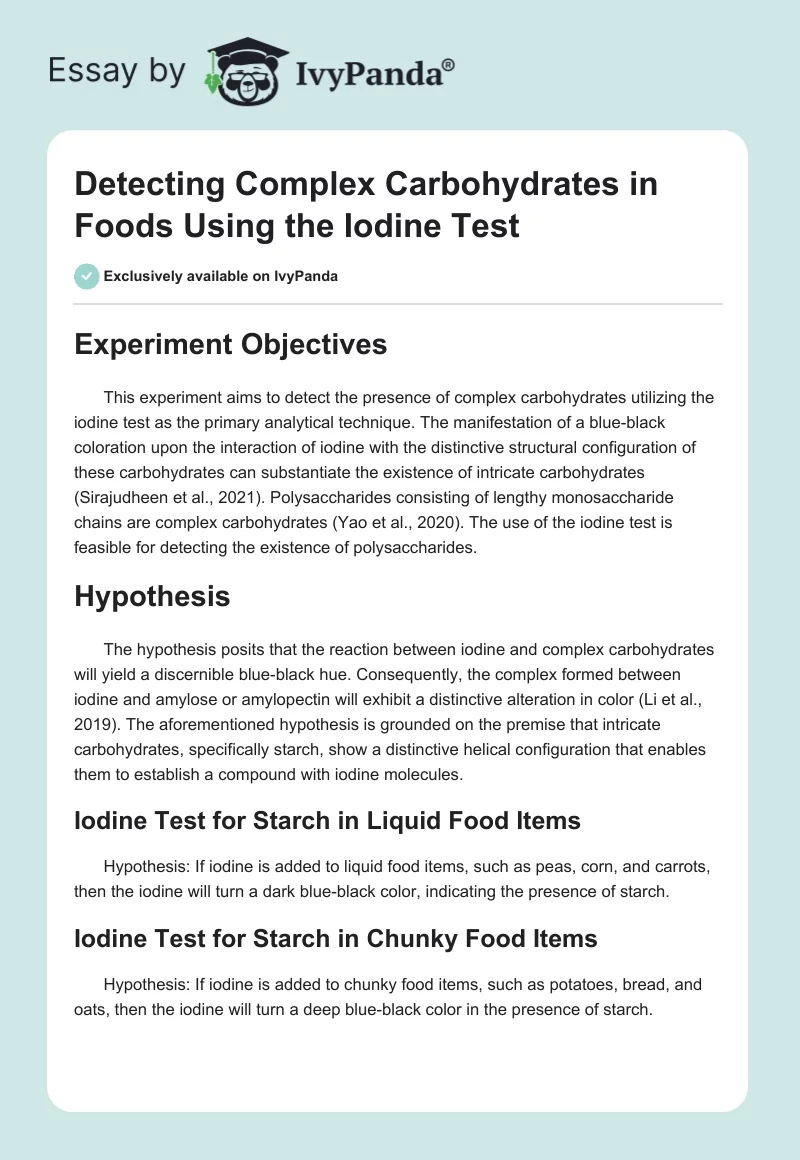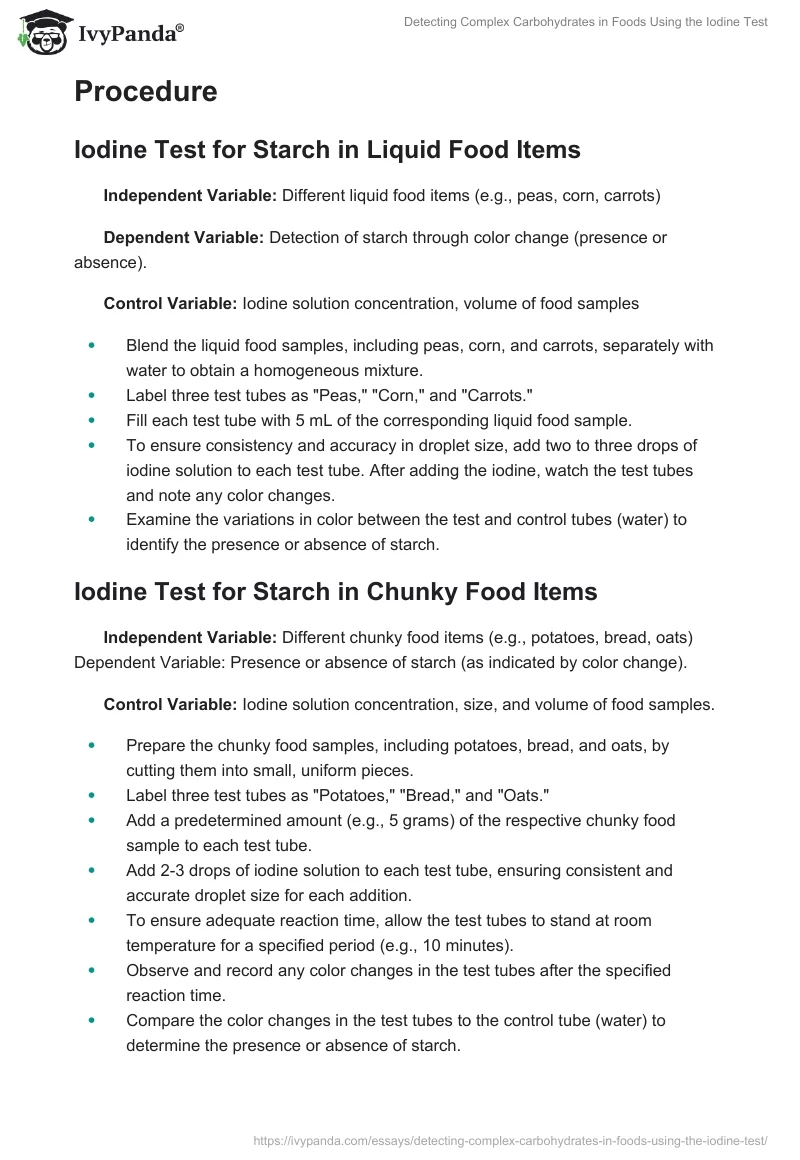Experiment Objectives
This experiment aims to detect the presence of complex carbohydrates utilizing the iodine test as the primary analytical technique. The manifestation of a blue-black coloration upon the interaction of iodine with the distinctive structural configuration of these carbohydrates can substantiate the existence of intricate carbohydrates (Sirajudheen et al., 2021). Polysaccharides consisting of lengthy monosaccharide chains are complex carbohydrates (Yao et al., 2020). The use of the iodine test is feasible for detecting the existence of polysaccharides.
Hypothesis
The hypothesis posits that the reaction between iodine and complex carbohydrates will yield a discernible blue-black hue. Consequently, the complex formed between iodine and amylose or amylopectin will exhibit a distinctive alteration in color (Li et al., 2019). The aforementioned hypothesis is grounded on the premise that intricate carbohydrates, specifically starch, show a distinctive helical configuration that enables them to establish a compound with iodine molecules.
Iodine Test for Starch in Liquid Food Items
Hypothesis: If iodine is added to liquid food items, such as peas, corn, and carrots, then the iodine will turn a dark blue-black color, indicating the presence of starch.
Iodine Test for Starch in Chunky Food Items
Hypothesis: If iodine is added to chunky food items, such as potatoes, bread, and oats, then the iodine will turn a deep blue-black color in the presence of starch.
Procedure
Iodine Test for Starch in Liquid Food Items
Independent Variable: Different liquid food items (e.g., peas, corn, carrots)
Dependent Variable: Detection of starch through color change (presence or absence).
Control Variable: Iodine solution concentration, volume of food samples
- Blend the liquid food samples, including peas, corn, and carrots, separately with water to obtain a homogeneous mixture.
- Label three test tubes as “Peas,” “Corn,” and “Carrots.”
- Fill each test tube with 5 mL of the corresponding liquid food sample.
- To ensure consistency and accuracy in droplet size, add two to three drops of iodine solution to each test tube. After adding the iodine, watch the test tubes and note any color changes.
- Examine the variations in color between the test and control tubes (water) to identify the presence or absence of starch.
Iodine Test for Starch in Chunky Food Items
Independent Variable: Different chunky food items (e.g., potatoes, bread, oats) Dependent Variable: Presence or absence of starch (as indicated by color change).
Control Variable: Iodine solution concentration, size, and volume of food samples.
- Prepare the chunky food samples, including potatoes, bread, and oats, by cutting them into small, uniform pieces.
- Label three test tubes as “Potatoes,” “Bread,” and “Oats.”
- Add a predetermined amount (e.g., 5 grams) of the respective chunky food sample to each test tube.
- Add 2-3 drops of iodine solution to each test tube, ensuring consistent and accurate droplet size for each addition.
- To ensure adequate reaction time, allow the test tubes to stand at room temperature for a specified period (e.g., 10 minutes).
- Observe and record any color changes in the test tubes after the specified reaction time.
- Compare the color changes in the test tubes to the control tube (water) to determine the presence or absence of starch.
Results
Iodine Test for Starch in Liquid Food Items

In the iodine test for starch in liquid food substances, the presence of starch was identified by the color shift of the iodine solution. Tube #2 (peas) and Tube #3 (carrots) turned a blue-black color upon adding iodine, indicating starch’s presence. However, Tube #1 (water) and Tube #4 (corn) showed no color change, suggesting the absence of starch. Tube #5 served as a negative control, confirming that the iodine solution did not produce a color change in the absence of starch.
Iodine Test for Starch in Solid Food Items

In the iodine test for starch in solid food items, the presence of starch was determined by the color change of the iodine solution. Tube #2 (potatoes) changed to a blue-black hue after adding iodine, indicating the presence of starch. However, Tube #1 (water), Tube #3 (bread), and Tube #4 (oats) did not change color, suggesting that starch was absent.. Tube #5 Functioned as a negative control, demonstrating that the iodine solution did not alter its color without the presence of starch.
Discussion
Iodine Test for Starch in Liquid Food Items
The hypothesis for this experiment suggested that adding iodine to liquid food items like peas, maize, and carrots would cause the iodine to change color from light blue to dark blue, showing the presence of starch. The iodine test for starch in liquid foods showed some intriguing findings in the trial. The blue-black hue detected starch developed in Tubes 2 (peas) and 3 (corn). Creating the blue-black hue with the iodine solution and forming a compound with starch molecules is consistent with the idea.
However, neither Tube #1 (water) nor Tube #4 (carrots) altered in color when iodine was added. This demonstrates that these samples do not contain any starch. Water in Tube #5 was a negative control and did not change color, proving that the iodine solution did not cause a false positive. This experiment’s findings support the theory. The iodine test for starch in liquid food products is valid since the observed color changes in the presence and absence of starch correspond with the expected results.
Iodine Test for Starch in Solid Food Items
It was hypothesized that starchy foods like potatoes, bread, and apples would turn a dark blue-black hue when iodine is added. The results of an iodine test for starch in solid foods were surprising. The blue-black tint in Tube 2 (potatoes) confirms the presence of starch and, hence, the theory’s validity. Starch’s blue-black hue comes from its complex carbohydrate structure reacting with iodine to produce the color.
The addition of iodine did not result in any noticeable color change in Tubes #1 (water), #3 (bread), or #4 (oats). This indicates that these foods do not contain any starch. Tube #5 (water) functioned as a control and showed no change, proving that the iodine solution did not produce a false positive. The iodine test successfully identified the presence or lack of starch in solid food products, supporting the theory. This experiment’s null hypothesis is thus accepted.
References
Li, H., Dhital, S., Slade, A. J., Yu, W., Gilbert, R. G., & Gidley, M. J. (2019). Altering starch branching enzymes in wheat generates high-amylose starch with novel molecular structure and functional properties. Food Hydrocolloids, 92, 51-59. Web.
Sirajudheen, P., Poovathumkuzhi, N. C., Vigneshwaran, S., Chelaveettil, B. M., & Meenakshi, S. (2021). Applications of chitin and chitosan based biomaterials for the adsorptive removal of textile dyes from water—A comprehensive review. Carbohydrate polymers, 273. Web.
Yao, T., Chen, M. H., & Lindemann, S. R. (2020). Structurally complex carbohydrates maintain diversity in gut-derived microbial consortia under high dilution pressure. FEMS Microbiology Ecology, 96(9). Web.


